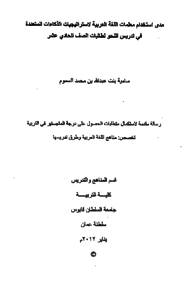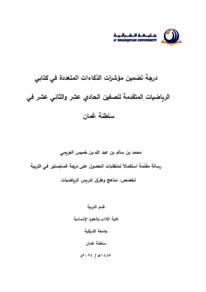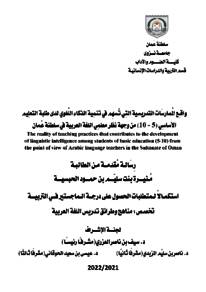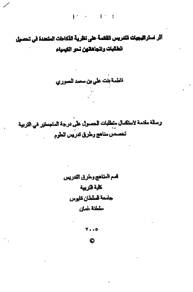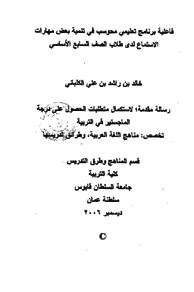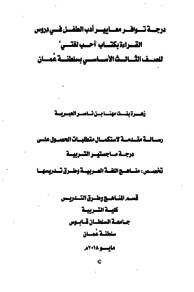Document
مدى استخدام معلمات اللغة العربية لاستراتيجيات الذكاءات المتعددة في تدريس النحو لطالبات الصف الحادي عشر
Publisher
جامعة السلطان قابوس
Gregorian
2012
Language
Arabic
Subject
English abstract
The present study aimed to investigate the use strategies of multiple intelligences by Arabic language teachers in teaching grammar to eleventh grade students. The research questions addressed are:
1. What are the strategies of multiple intelligences required in the performance of the Arabic language teachers in the teaching grammar?
2. To what extent do Arabic language teachers use the strategies of multiple intelligences in teaching grammar to students of eleventh grade?
In order to answer these questions, the researcher used the descriptive and analytical approach where the researcher prepared an observation checklist incorporating multiple intelligences strategies required in the performance of the Arabic language when teaching grammar. The instrument was validated by a group of experts. The reliability of the instrument was also checked through using another observer. The intercoder reliability was calculated Cooper's formula and the agreement percentage was 91.03. The study yielded the following findings:
1- The construction of an observation checklist consisting of 25 strategies equally distributed among the five types of multiple intelligences: linguistic, logical/mathematical, visual/spatial, physical/kinesthetic, and social.
2- The ranking of the intelligences in the use of Arabic language teachers in the classroom while teaching grammar to eleventh grade students in a descending order is logical/mathematical intelligence (average 3.06 and 76.5%), linguistic intelligence (average 2.648 and 66.4%), social intelligence (average 2.58 and 64.5%), physical/kinesthetic (average 2.184 and 54.6%) and visual spatial intelligence (average 1.624 and 40.6%).
The findings of the study provided several recommendations such as diversifying the teaching methods of Arabic language in general and grammar in particular, and taking advantage of the multiple intelligences theory in improving the level of students achievement. Another recommendation is to acquaint pre-service student teachers and in-service teachers with the multiple intelligences theory and training them on implementing its different strategies in teaching Arabic language in general and grammar in particular. It is also recommended to increase the awareness about multiple intelligences theory and including its associated educational applications in the Arabic language courses offered at the colleges of education to undergraduate and masters students. Finally, other studies investigating the relationship between multiple intelligences theory and teaching Arabic language as well as its effectiveness in improving Omani students achievements.
Member of
Resource URL
Arabic abstract
هدفت الدراسة الحالية إلى تعرف مدى استخدام معلمات اللغة العربية لاستراتيجيات الذكاءات المتعددة في تدريس النحو لطالبات الصف الحادي عشر، وذلك من خلال الإجابة عن السؤالين التاليين:
١- ما استراتيجيات الذكاءات المتعددة اللازم توافرها في أداء معلمات اللغة العربية في تدريس النحو؟
٢- ما مدى استخدام معلمات اللغة العربية لاستراتيجيات الذكاءات المتعددة في تدريس النحو الطالبات الصف الحادي عشر؟
وللإجابة عن السؤالين السابقين استخدمت الباحثة المنهج الوصفي التحليلي؛ حيث قامت الباحثة بإعداد بطاقة ملاحظة ضمت استراتيجيات الذكاءات المتعددة اللازم توافرها في أداء معلمات اللغة العربية في تدريس النحو، وقد تم التأكد من صدقها بعرضها على مجموعة من المحكمين، كما تم التأكد من ثباتها عن طريق الاستعانة بملاحظ آخر، كما تم حساب نسبة الاتفاق بين الباحثة والملاحظ الآخر عن طريق معادلة كوبر؛ حيث بلغت نسبة الاتفاق بين الملاحظين (91.03) وقد أسفرت الدراسة عن النتائج التالية: ١- التوصل إلى بطاقة الملاحظة المكونة من (25) استراتيجية موزعة بالتساوي على خمسة أنواع من الذكاءات المتعددة هي: اللغوي، والمنطقي الرياضي، والبصري المكاني، والجسمي الحركي، والاجتماعي ۲- جاء ترتيب الذكاءات في استخدام معلمات اللغة العربية لها في الموقف الصفي في أثناء تدريسهن النحو لطالبات الصف الحادي عشر تنازليا كالتالي: الذكاء المنطقي الرياضي بمتوسط (3.06)، ونسبة مئوية (76.5 %)، يليه الذكاء اللغوي بمتوسط (2.64)، ونسبة مئوية (66.4 %) ثم الذكاء الاجتماعي بمتوسط (2.58)، ونسبة مئوية (64.5 %) والذكاء الجسمي الحركي بمتوسط (2.18)، ونسبة مئوية ( %54 , 6 )، وأخيرا الذكاء البصري المكاني بمتوسط ( 1.62)، ونسبة مئوية (%40.6)
وفي ضوء ما توصلت إليه الدراسة من نتائج قدمت عدة توصيات من أهمها: تنويع طرائق تدريس اللغة العربية بشكل عام، والنحو بشكل خاص، والاستفادة من نظرية الذكاءات المتعددة في رفع المستوى التحصيلي للطلاب. وتعريف الطلاب المعلمين بها قبل الخدمة وفي أثنائها، وتدريبهم على تطبيق استراتيجياتها في تدريس اللغة العربية عموما والنحو خصوصا، كذلك الاهتمام بنظرية الذكاءات المتعددة، وتضمين ما يرتبط بها من تطبيقات تربوية في مقررات تدريس اللغة العربية، لطلاب كليات التربية في مرحلتي البكالوريوس، والماجستير. كما اقترحت إجراء دراسات أخرى تتعلق بالذكاءات المتعددة وتدريس اللغة العربية، واختبار فاعليتها في رفع المستوى التحصيلي لدى طلاب السلطنة.
١- ما استراتيجيات الذكاءات المتعددة اللازم توافرها في أداء معلمات اللغة العربية في تدريس النحو؟
٢- ما مدى استخدام معلمات اللغة العربية لاستراتيجيات الذكاءات المتعددة في تدريس النحو الطالبات الصف الحادي عشر؟
وللإجابة عن السؤالين السابقين استخدمت الباحثة المنهج الوصفي التحليلي؛ حيث قامت الباحثة بإعداد بطاقة ملاحظة ضمت استراتيجيات الذكاءات المتعددة اللازم توافرها في أداء معلمات اللغة العربية في تدريس النحو، وقد تم التأكد من صدقها بعرضها على مجموعة من المحكمين، كما تم التأكد من ثباتها عن طريق الاستعانة بملاحظ آخر، كما تم حساب نسبة الاتفاق بين الباحثة والملاحظ الآخر عن طريق معادلة كوبر؛ حيث بلغت نسبة الاتفاق بين الملاحظين (91.03) وقد أسفرت الدراسة عن النتائج التالية: ١- التوصل إلى بطاقة الملاحظة المكونة من (25) استراتيجية موزعة بالتساوي على خمسة أنواع من الذكاءات المتعددة هي: اللغوي، والمنطقي الرياضي، والبصري المكاني، والجسمي الحركي، والاجتماعي ۲- جاء ترتيب الذكاءات في استخدام معلمات اللغة العربية لها في الموقف الصفي في أثناء تدريسهن النحو لطالبات الصف الحادي عشر تنازليا كالتالي: الذكاء المنطقي الرياضي بمتوسط (3.06)، ونسبة مئوية (76.5 %)، يليه الذكاء اللغوي بمتوسط (2.64)، ونسبة مئوية (66.4 %) ثم الذكاء الاجتماعي بمتوسط (2.58)، ونسبة مئوية (64.5 %) والذكاء الجسمي الحركي بمتوسط (2.18)، ونسبة مئوية ( %54 , 6 )، وأخيرا الذكاء البصري المكاني بمتوسط ( 1.62)، ونسبة مئوية (%40.6)
وفي ضوء ما توصلت إليه الدراسة من نتائج قدمت عدة توصيات من أهمها: تنويع طرائق تدريس اللغة العربية بشكل عام، والنحو بشكل خاص، والاستفادة من نظرية الذكاءات المتعددة في رفع المستوى التحصيلي للطلاب. وتعريف الطلاب المعلمين بها قبل الخدمة وفي أثنائها، وتدريبهم على تطبيق استراتيجياتها في تدريس اللغة العربية عموما والنحو خصوصا، كذلك الاهتمام بنظرية الذكاءات المتعددة، وتضمين ما يرتبط بها من تطبيقات تربوية في مقررات تدريس اللغة العربية، لطلاب كليات التربية في مرحلتي البكالوريوس، والماجستير. كما اقترحت إجراء دراسات أخرى تتعلق بالذكاءات المتعددة وتدريس اللغة العربية، واختبار فاعليتها في رفع المستوى التحصيلي لدى طلاب السلطنة.
Category
Theses and Dissertations

